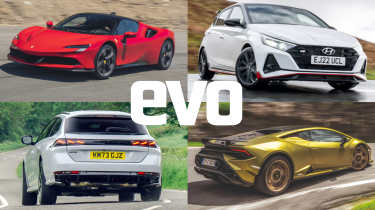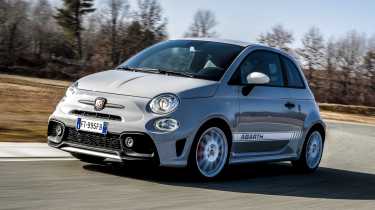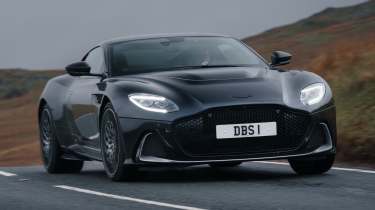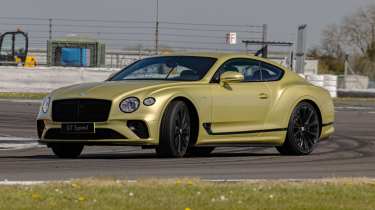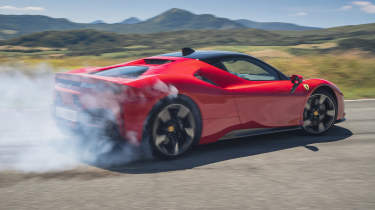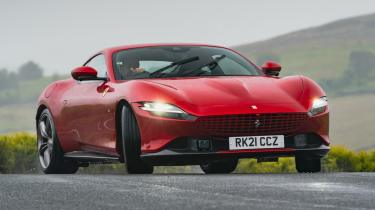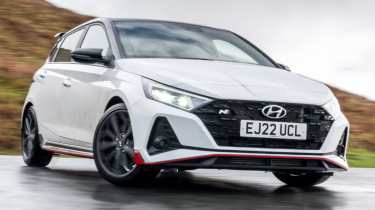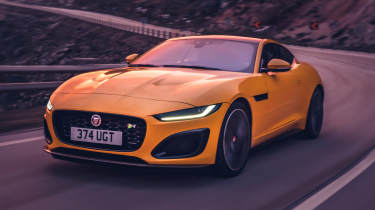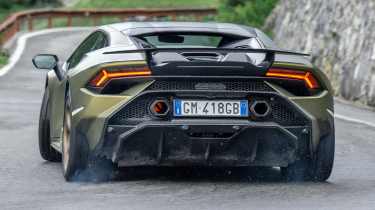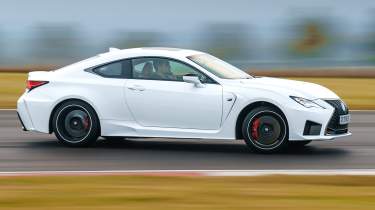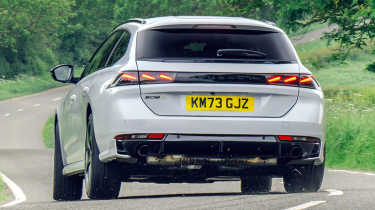Cars that ended production in 2024
As we look forward to 2025 and the new cars that are on the horizon, many evo favourites won't be in showrooms after the new year
As the year draws to a close, not only are we looking ahead at what’s to come in 2025 but also reflecting on cars which have been retired by manufacturers in 2024, either for good, or ahead of the introduction of a successor. It feels only appropriate to acknowledge what have been a number of key models for evo over the years, as they leave dealerships for the final time and enter the history books.
The last couple of years have been tumultuous in terms of household names being put out to pasture. Some, like the Ford Fiesta, have been around for decades. Others, like the Audi TT and Audi R8, while not as long-lived, have become a part of the furniture in the segments they occupied. All were offed in 2023 and now, these key models follow in their tyre tracks.
Abarth 595
Some might say it overstayed its welcome, others would respond by saying it sold strongly until the last. The Abarth 595 and 695 ended production this year, some 16 years on from the introduction of the Abarth 500, from which they spawned. Never class-leading cars, never with more than 178bhp at their disposal, but these little Abarths have always brought a welcome dose of fun to the hot hatch segment. Rightly so, as humour and entertainment are a big part of hot hatches’ appeal.
Many faster hot hatches have seemed to forget that over the years and so, towards the end of their production run, time behind the wheel of one of the Abarth models served as something of a palette cleanser and a reminder that, even if they were not the most objectively talented, a hot hatch should charm you and make you smile. The petrol Abarth does and doesn’t have a direct successor: the new Abarth 500e is an EV and very different in character and capability from the car it succeeds.
Aston Martin DBS
The DBS, meanwhile, is one of what is now a long line of V12-engined flagship Aston Martin GTs, with the latest, the third-generation Vanquish, taking its place for 2025.
Joining the line-up in 2018 as the DBS Superleggera, the outgoing car replaced the previous Vanquish, one of the last models of Aston Martin’s VH architecture era, which began with the DB9 in 2003. As the first flagship to use a version of the 5.2-litre twin-turbo V12 which replaced the 5.9-litre naturally aspirated engine, it also became the most powerful production Aston yet made on its introduction, with 715bhp and 664lb ft.
> Best Aston Martins – the greatest hits from Britain’s sports car icon
It wasn’t a perfect car upon release, without the utmost dynamic aptitude to put its potency to the fullest use, at least by comparison to rivals like the Ferrari 812 Superfast. As the years went on, though, Aston nipped and tucked its top-tier GT, dropping the ‘Superleggera’ part of its name before too long. It was never that lightweight, anyway…
The DBS 770 Ultimate arrived last year as the final Aston Martin DBS and one of the very best cars the marque has ever made. Based on our initial drive, the new Aston Martin Vanquish is even better still but nonetheless, we’ll miss the handsome brute that was the DBS.
Bentley Continental GT W12
In 2024, however, it was rarer for a 12-cylinder model to be succeeded than for it to die out altogether. On that point, Bentley, one of the strongest sellers of 12-cylinder cars over the last two decades, put its famous W12 engine to rest after building more than 100,000 of them. This entry might be labelled Continental GT W12 but in reality, this is a eulogy for the engine as a whole, with the mill dropped from service in everything from the Continental GT to the Bentayga SUV.
The brainchild of Ferdinand Piëch, the W12 was introduced in the 2003 Continental GT, affording it a 552bhp, 479lb ft punch. That’s a lot today, let alone 21 years ago, even in what was a 2350kg GT car. It was a paragon of potency, smoothness, relatively compact packaging and, in the end, relative efficiency. But it was never the most emotional engine, in terms of its vocals or the nature of its power delivery.
Continentals have always been brutally yet sure-footedly and eloquently effective in their performance, rather than the most involving cars. Realistically, the kind of growl or wail many relish from an Aston Martin or a Ferrari was never in the brief for the Bentleys the W12 powered. Nonetheless, many will miss this singular and special engine. The new ultra high-performance hybrid-powered Continental GT Speed has quite a legacy to carry.
Ferrari SF90
A 5998cc twin-turbo 12-cylinder being confined to the history books in 2024 shouldn’t come as a surprise. What was more odd was watching the same happen to a plug-in hybrid. Okay, Maranello’s first PHEV, the Ferrari SF90, is hardly representative of the kinds of electrified cars that are being given the legislative steer at the moment. Nevertheless, one might assume it’s the kind of car that makes more sense for Ferrari to carry in its line-up now than it did at launch.
It has over its five years on sale both amazed and polarised testers at evo. It famously finished last in 2021’s Car of the Year test, behind the Hyundai i20 N (another car that’s been retired in 2024). Its twin-turbo V8 engine was augmented by three electric motors – one on the gearbox and one apiece powering the front wheels. They were fed by a 7.9kWh battery, meaning the SF90 could be driven in silent electric mode for up to 16 miles.
> Best Ferraris – evo’s favourite road cars from Maranello
It was technically incredibly sophisticated and impressive in performance but for some testers, it fell short as a cohesive driving experience, at least to begin with. It got better over the years as Ferrari refined the formula, with the SF90 XX seeing the car out with a fantastic final flourish. It became one of the great driving experiences in the end, and stands as a benchmark against which the new Aston Martin Valhalla will be measured in 2025.
Ferrari Roma
A few Ferraris disappeared from sale in 2024. At the opposite end of the scale to the SF90, what could be described as the ‘entry-level’ Ferrari also bowed out. The Roma is an achingly elegant front-engined GT featuring a 612bhp 3.9-litre twin-turbo V8, sending power exclusively to the rear wheels. There’s no hybrid drive, no all-wheel drive, no electric-only modes. It is about as traditional as Ferraris get, save for having a V8 instead of a V12.
It was a car that performed exactly as you’d expect it to, based on its brief and its appearance. More sporting and more composed than an equivalent Bentley or Aston Martin but plusher, prettier and more cossetting than a McLaren or Porsche, the Roma will be remembered as a Goldilocks car that could turn a wheel to all pursuits.
> Ferrari Roma v Lexus LC500 v Bentley Continental GT V8 v Aston Martin DB11 AMR
From a 180mph autobahn dash to a trans-Alpine thrash, the Roma’s skillset was satisfyingly broad. Its successor, due next year potentially with some electrical augmentation, has big – but elegant – shoes to fill.
Hyundai i20 N
In reality, it isn’t the upper echelons of the performance and premium car space that have depleted most over recent years. It’s the more accessible end – the hot hatches – that are currently closest to extinction. Latest to depart is the fabulous Hyundai i20 N, a car conceived from the outset to fight the Ford Fiesta ST on its home turf.
It was launched back in 2021; here at the end of 2024, it’s now been more than a year since it’s been possible to order a Fiesta ST, or any new Fiesta for that matter. Subjectively, it didn’t quite have the damping polish or steering response to match that of the Fiesta but it’s an outstanding performance car nonetheless.
As for a replacement, the Hyundai and many cars of its type are disappearing without direct successors to take their place. It’s a rapidly changing automotive landscape, legislatively and in terms of how much cars cost to produce. A small car with slim profit margins and big emissions for its size is far from what manufacturers need right now.
The electric Hyundai Ioniq 5 N now carries the N mantle and, while excellent, it’s a very different car from the i20 N and indeed, the Hyundai i30 N, which has also departed.
Jaguar F-Type
Another long-serving star to depart this year was the Jaguar F-Type. Launched in 2013, the F-Type was a long time coming, with a car so-named teased as far back as 2000 (and rumoured at numerous intervals before that too). The production car was one in a long line of new starts for the marque and arguably, the most convincing to date.
For here was a beautiful sports GT and roadster, bristling with character that charmed all who encountered it. For the first time in a long time, a beautiful Jaguar had dynamic prowess and performance to match its good looks. In 542bhp R Coupe form it was runner up in 2014’s evo Car of the Year test, coming second only to the Ferrari 458 Speciale.
> Best Jaguars – big cats that defined the breed
The F-Type was available with a supercharged V6 and even a four-cylinder turbocharged engine over the years, but it’s the crackling, gargling supercharged 5-litre V8 – an engine that’s also now out of production – that will be remembered best. With monstrous power (up to 567bhp in SVR spec) and barrels of character, there are very few engines still around today that can get under your skin quite like it.
Lamborghini Huracán
With the passing of the Lamborghini Huracán, the marque’s second junior supercar of this century, it also puts to bed its universally adored 5.2-litre V10. Yet even though that engine was always the centre of attention, it would be to do the Huracán a disservice to remember it for that and that alone. On its introduction, the Huracán was flawed – numb, understeer-prone, with absolutely back-breaking seats. But an epic turnaround and run of form was to come.
The original Huracán RWD was the first sign of progress but the brilliant Performante was the real shock. Then came the dynamically revolutionised Huracán Evo models, the spellbinding Huracán STO, the excellent Huracán Tecnica and, finally, the absurd yet utterly beguiling off-road Sterrato.
> Best Lamborghinis – the all-time great raging bulls
What the Huracán never gained too much of in its ten years on sale, was power. It arrived in 2014 with 602bhp and it departs in 2024 with 631bhp, in all-out STO spec. That, if anything, speaks of the Huracán as a car which evolved its breadth of talents and appeal rather than depending on lunges in power output to grab headlines. Lamborghini certainly got something right because it managed to shift almost 30,000 cars over the model’s lifetime.
The hybridised, twin-turbo V8-powered Lamborghini Temerario is set to turn that on its head, arriving next year with 907bhp – over 300bhp more than the original Huracán.
Lexus RC F
The Lexus RC F was never a group test darling. In its nine years on sale, it didn’t put the F82 BMW M4 or Mercedes-AMG C63 Coupe behind it in the standings, subjective or objective. The Lexus couldn’t outshine an M car to drive and the equivalent Mercedes always had more muscle. But it was one of those cars that charmed and beguiled as you covered miles in it.
Its singing 5-litre 470bhp DOHC V8 already felt like a powerplant from a bygone era when it debuted in 2015, let alone as it departs in 2024. Far from an anachronism, it was always a reminder that many other engines traded character for brute-force performance when turbocharging took over.
> Ford Mustang Mach 1 v Lexus RC F – rear-drive V8 coupes go head-to-head
That the RC F lived as long as it did is a bit of a surprise because it was never a big seller. It was always the alternative choice; the car you give a knowing nod to on the rare occasion you see one in the wild. The same goes for the beautiful Lexus LC with which it shared showrooms and that wonderful engine, which also left the company’s line-up earlier this year.
Peugeot 508 PSE
A bit of an outlier, is the Peugeot 508 PSE, in every sense. On this list, in the market – it’s something of an oddball.
The Peugeot Sport Engineered sub-brand didn’t live very long, with the 508 PSE the only production car to come out of the project. The ingredients don’t sound spectacular, with a 1.6-litre turbocharged four-cylinder paired with a hybrid system, but that engine is an ex-GTi powerplant. It’s a performant, responsive engine with reasonable character, well integrated with the two electric motors.
> Peugeot 508 PSE v Skoda Octavia vRS – fast family estates do battle
Altogether, the 508 PSE has a healthy 355bhp to call upon and the temptation is often there to do so, given the chassis is engaging and rewarding. Far from a big seller, it’s no real surprise the 508 PSE, which was an expensive and depreciation-prone model, is signing off. But it’s a little sad that it is, because it was a truly interesting and talented alternative to the German establishment.
